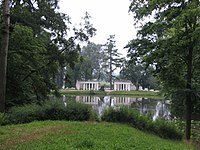Bila Tserkva
Bila Tserkva
Бiла Церква | |
|---|---|
 The "white church" of Bila Tserkva. | |
|
| |
 | |
| Country Oblast Raion | Ukraine Kiev Oblast Bila Tserkva City Municipality |
| Founded | 1032 |
| Magdeburg Rights | 1589 |
| Government | |
| • Head of City Council | Vasyl Savchuk |
| Area | |
| • Total | 34 km2 (13 sq mi) |
| Population (01-01-2004) | |
| • Total | 203,300 |
| est. | |
| Postal code | 09100-09117 |
| Area code | +380 4563 |
| Sister cities | Barysaw |
| Website | http://www.bilatserkva.info/ |
Bila Tserkva (Ukrainian: Бiла Церква, Russian: Белая Церковь, literally White Church) is a city located on the Ros' River in the Kiev Oblast (province) in central Ukraine, approximately 80 km (50 mi) south of the capital, Kiev. Population 203,300 (January 1, 2004 est.) Area 34 km².[1]
Administrative status

Serving as the administrative center of the Bilotserkivskyi Raion (district), Bila Tserkva is a city of oblast subordinance thus being subject directly to the oblast authorities rather to the raion administration housed in the city itself.
History
The town was founded in 1032 as Yuriev by Yaroslav the Wise, whose Christian name was Yuri. The present name of the city, literally translated, is "White Church" and may refer to the (no longer existing) white-painted cathedral of medieval Yuriev.
Since 1363 it belonged to the Grand Duchy of Lithuania, and since 1569 to the Polish-Lithuanian Commonwealth. Was granted Magdeburg Rights in 1620 by Sigismund III Vasa. A peace treaty between the Polish-Lithuanian Commonwealth and Ukrainian Cossack rebels under Bohdan Khmelnytsky was signed here in 1651.
After the Third Partition of Poland in 1795 Bila Tserkva came into Imperial Russia. It was a significant market place in the 19th century. During the Soviet times it became a large industrial center (machine building, construction industry).
Preceding the Russian Revolution and until the 1930s, there was a significant Jewish community here. Some were driven out by Cossacks and Tzarist policies. Many were driven out in the Stalinist purges. Most remnants were destroyed during the Holocaust and other losses during the Second World War.
Sights
Notable buildings include the covered market (1809-1814) and the complex of post buildings (1825-31). There are also Palladian wooden buildings of the Branickis' "Winter Palace" and the district nobility assembly. The church of St. Nicholas was started in 1706 but was not completed until 1852. The Orthodox cathedral of the Saviour's Transfiguration was constructed in 1833-1839, while the Catholic church dates to 1812.

A historical landscape park "Alexandria" of 2 km2 (0.77 sq mi) is situated in Bila Tserkva. It was founded in 1793 by the wife of the Polish hetman Franciszek Ksawery Branicki.
Activities
The city is home to the major automobile tire manufacturer "Rosava" and the football team FC Ros' Bila Tserkva. Ros is a team in the lower levels of the Ukrainian Football League.
Famous people
- David Bronstein - Leading chess grandmaster and writer.
- Volodymyr Dyudya- Ukrainian cyclist.
- Lyudmila Pavlichenko - World War II Soviet sniper
- Olexandr Medvid' - a famous Soviet/Belarusian wrestler.
- Yuriy Zagorodniy - Footballer
- Yuri Linnik- soviet mathematician
- Shmuel Yerushalmi - Israeli protest poet
- Vadim Lazarkevich - Russian–Bulgarian illustrator
References
- ^ General information about the city, at Bila Tserkva official web-site
- ^ For more images of the park "Alexandria", see klymenko.data-tec.net
External links
- Street Angels (UKRAINE) - Website of StreetRacer's in Bila Tserkva
- Bila Tserkva city of Good - Official Bila Tserkva city webportal in Ukrainian
- BilaTserkva.com - Bila Tserkva Talks (In Ukraine with English sections)
- Bila Tserkva Forum - Bila Tserkva city Forum
- Radio Net - Website of local live internet streaming radio
- bila.com.ua - enterprise catalogue Bila Tserkva
- all links - Web-resources catalogue Bila Tserkva
- GRIF Newspaper - Bila Tserkva Ukrainian newspaper
- City WebCam Live view on Yaroslav the Wise street
- 09 Bila Tserkva phone book
- Photos of Bila Tserkva
- [1]- Bila Tserkva park Oleksandriya
- Latest news in our city

